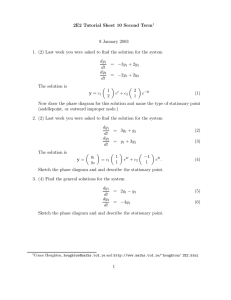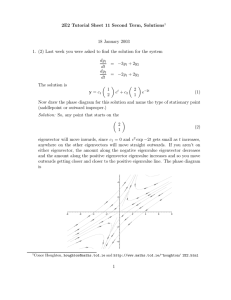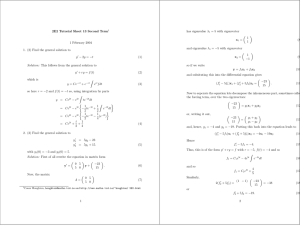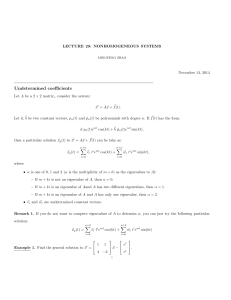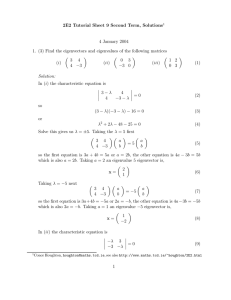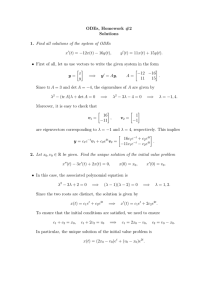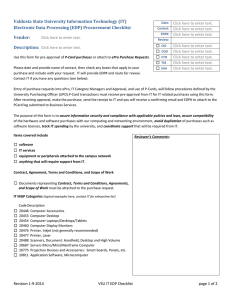2E2 Tutorial Sheet 12 Second Term dy = 3y
advertisement
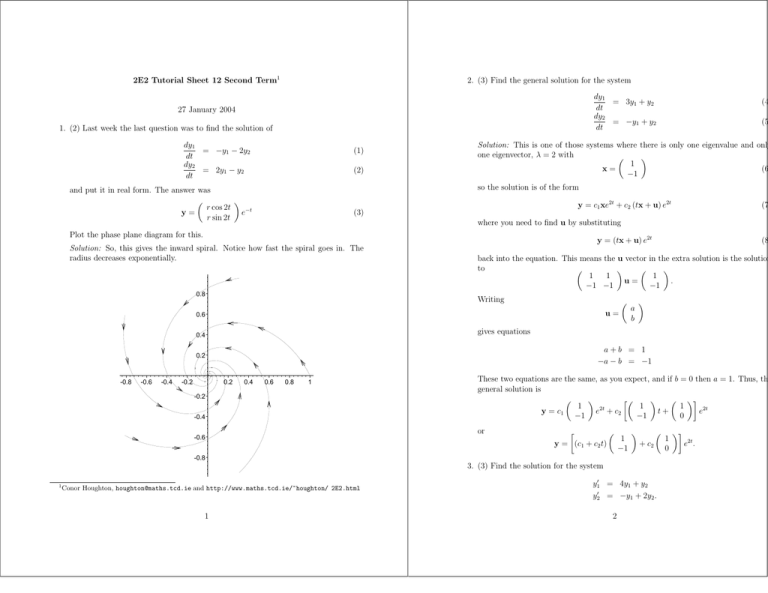
2E2 Tutorial Sheet 12 Second Term1 2. (3) Find the general solution for the system dy1 = 3y1 + y2 dt dy2 = −y1 + y2 dt 27 January 2004 1. (2) Last week the last question was to find the solution of dy1 = −y1 − 2y2 dt dy2 = 2y1 − y2 dt (1) (2) Solution: This is one of those systems where there is only one eigenvalue and only one eigenvector, λ = 2 with 1 x= (6 −1 y = c1 xe2t + c2 (tx + u) e2t (3) Solution: So, this gives the inward spiral. Notice how fast the spiral goes in. The radius decreases exponentially. 0.8 y = (tx + u) e2t Writing u= a b gives equations 0.4 a+b = 1 −a − b = −1 0.2 -0.2 0.2 0.4 0.6 0.8 1 -0.2 -0.4 -0.6 These two equations are the same, as you expect, and if b = 0 then a = 1. Thus, th general solution is 1 1 1 e2t e2t + c2 t+ y = c1 0 −1 −1 or 1 1 e2t . y = (c1 + c2 t) + c2 0 −1 -0.8 3. (3) Find the solution for the system 1 Conor Houghton, houghton@maths.tcd.ie and http://www.maths.tcd.ie/~houghton/ 2E2.html 1 (8 back into the equation. This means the u vector in the extra solution is the solution to 1 1 1 u= . −1 −1 −1 0.6 -0.4 (7 where you need to find u by substituting Plot the phase plane diagram for this. -0.6 (5 so the solution is of the form and put it in real form. The answer was r cos 2t y= e−t r sin 2t -0.8 (4 y10 = 4y1 + y2 y20 = −y1 + 2y2 . 2 with initial conditions y1 (0) = 3 and y2 (0) = 2. Solution: A= 4 1 −1 2 (9) and there is only one eigenvector, x= −1 1 (10) with eigenvalue λ = 3. The solution is y = c1 xeλt + c2 (tx + u)eλt (11) (A − λ1) u = x (12) where u satisfies and so, in this case, 1 1 −1 −1 u= u= −1 0 and a solution to this is −1 1 (13) (14) and so the solution is y = c1 −1 1 Now, putting t = 0 we get 3 2 −1 −1 e3t + c2 t + e3t 1 0 = c1 −1 1 + c2 −1 0 (15) (16) and, hence, 3 = −c1 − c2 2 = c1 aso c2 = 1 and c2 = −5 giving −1 −1 −1 e3t + e3t − 5 t y=2 0 1 1 (17) (18) or y1 = (3 + 5t)e3t y2 = (2 − 5t)e3t 3 (19)
